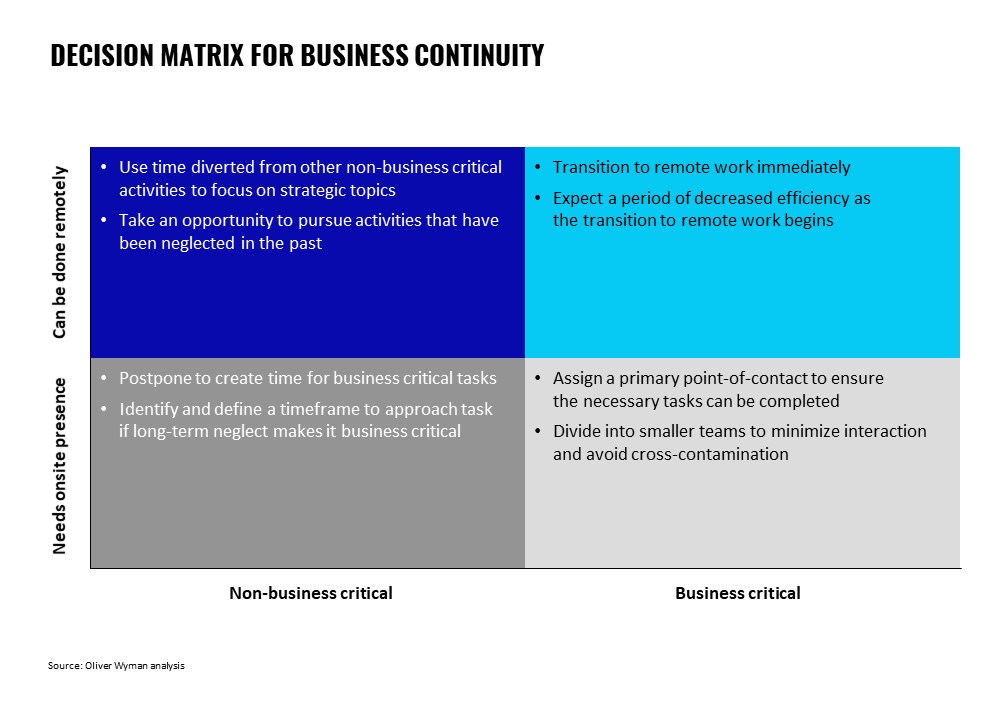This article was first published on March 18, 2020
With the coronavirus pandemic continuing to take shape globally, companies across virtually all industries are quickly acting to contain its spread and ensure business continuity. While utilities can generally put previously-developed plans into action for system critical functions involving infrastructure, such grid and power plant operations, other functions of the business such as retail operations and overhead functions are often less resilient.
It is important for utilities to consider an array of outcomes of the potential outcome of COVID-19 and the impact that they will have on their employees, their customers, and their overall operations from the grid to the back office:
- The outbreak lasts three to four months: Serial outbreak largely resolves within a three- to four-month period, where complete global recovery takes until the fourth quarter or longer.
- It takes six to twelve months to regain control: More extensive period of disruption over a six-month period resulting in a slower pace of growth in impacted countries, with larger economies better suited to weather the slowing growth.
- The pandemic extends more than twelve months: Virus spreads widely and public remains in heightened state of anxiety, with drops in demand causing growth to slow. Companies in particularly vulnerable industries may trigger complications for other industries.
We make no comment in this note as to which of these is most likely, but we recommend utilities consider all such scenarios and plan accordingly. Utilities who plan for the survival minimum will be best placed to adapt their operations to any amount of uncertainty.
Regardless of the outcome, working from home is quickly becoming less of an option and more of a necessity in the near-term. With that, there are some measures that utilities can adopt to maintain business as usual across all functions.
Consider Organizational Matters
The first step to ensuring business continuity is to prioritize and assess the various processes and tasks involved in the day-to-day operations across the utility. Non-business critical tasks should be postponed to allocate more time and reassign personnel to business critical tasks, given the likely reduction of the available workforce, as personal matters arise such as school closures for children and sickness directly related to the coronavirus. There will also likely be a temporary period of reduced efficiency as employees transition and adapt to a remote working environment.
It is critical for utilities to regularly evaluate their business processes, as processes that are considered non-critical today may eventually become critical, thus requiring additional onsite workers. Regardless, any work that can be done remotely at a given time should be conducted remotely as soon as possible to reduce further infection risk.
There will likely be a temporary period of reduced efficiency as employees transition to remote working
For business-critical processes that require an onsite presence, there are different approaches that can be taken. While such processes simply cannot be conducted remotely, there are steps that can reduce the infection risk. With the concept of social distancing being encouraged by government officials, dividing teams into smaller groups and having them work in shifts will add physical distance between workers and help to avoid cross-contamination of tools and appliances. Reducing shift lengths can also help avoid contamination risk as it allows employees to work non-stop without a break, have minimal physical contact with areas in the building, and then travel directly home.

Build A Technology Toolkit
In order to ensure that employees can be as productive as possible when working remotely, it is important to arm them with the appropriate tools. While it is easy to simply supply employees with a laptop, making use of an array of software and hardware options is critical. For instance, rather than joining conference calls via telephone, utilities can conduct meetings related to non-critical functions over a video conferencing program. Such programs often enable users to share their screens to conduct presentations as if speaking to a boardroom and include moderator functions—to mute all participants and ask questions, when needed.
Providing a full suite of tools to foster communication, coordination, and co-working will help simulate the office environment
In today’s business environment, coordination is key. Therefore, remote employees will benefit from project management and advanced communication tools. These allow for quick status updates on processes and provide an outlet to ask a quick question when email may not be necessary. Equally important is the use of co-working tools that allow for seamless file transferring and collaboration with all team members being able to edit and comment, further promoting version control.
When it comes to technology, while many utility employees may be used to the standard office environment, providing a full suite of tools to foster communication, coordination, and co-working will help to simulate the office as much as possible.
Practice Effective Leadership
When confronting a global crisis, it is paramount for utility leadership to remain actively engaged in all components of the business—including its employees. Clear communication is key, and leadership should not be worried about providing too much communication. Communication should be clear and follow an organized plan, with the overall goal of keeping employees updated on new developments as they become available. When developing a communications plan, sharing both short- and long-term perspectives helps to instill a sense of security and structure.
Utility leadership serves as the first source of information and is essentially a multiplier for all efforts. To ensure that the flow of communication down from leadership through middle-managers, and on to other employees is consistent, utilities should consider providing a clear narrative and use an array of communication channels. This will help make sure that leadership and management is represented with one voice and that there are no misconceptions developed along the way. Developing a clear path of communication will also help to instill a sense of direction across the organization.
Regardless of the crisis at hand, messaging that emphasizes the core values of the organization helps to create a sense of belonging and alignment. When employee morale is at risk due to personal fears, it is important for leadership to be positive and show an optimistic—yet realistic—path forward.







